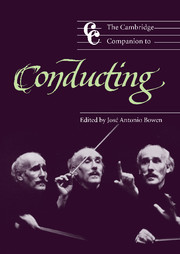Book contents
17 - Conducting early music
from Part III - Issues
Published online by Cambridge University Press: 28 September 2011
Summary
In Leipzig, Bach's predecessor Johann Kuhnau beat time with a rolled-up sheet of music paper, a common practice in church music (see Fig. 8.1). In Esterháaza, Haydn led his symphonies from the first violin, a typical practice in the symphonic music of his time and region. But in London, when Haydn directed his last symphonies, he sat at the keyboard and shared leadership with the first violinist. Shared leadership was common in opera: overall responsibility belonged to the maestro di capella at the keyboard while the instrumentalists were led by the first violinist. When Mozart directed his operas from the keyboard, he concentrated on the singers but also oversaw the entire performance.
These were the most common leadership practices of the eighteenth century. But today's historically informed performers almost never revive the rolled-up sheet of paper, and they lead from instruments only when the ensembles are relatively small – not, generally, in operas or large symphonies. Modern French Baroque specialists perform the ballet music of Jean-Baptiste Lully with careful consideration of the tension in the bow hairs, but rarely replicate his practice of beating time audibly with a stick. And in large late-eighteenth-century choral works, modern historical performers rarely revive “dual” direction, split between a time-beater for the chorus and an instrumentalist for the rest. Instead, performers typically use today's highly refined conducting technique.
- Type
- Chapter
- Information
- The Cambridge Companion to Conducting , pp. 237 - 248Publisher: Cambridge University PressPrint publication year: 2003

